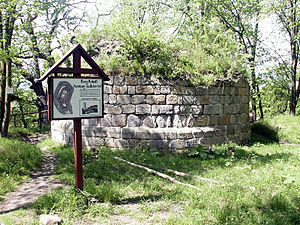Anhalt Castle
| Anhalt Castle | ||
|---|---|---|
|
Foundation of the keep |
||
| Creation time : | around 1123 | |
| Castle type : | Hilltop castle | |
| Conservation status: | Bergfriedstump, remains of the wall | |
| Standing position : | Count | |
| Construction: | Brick bricks | |
| Place: | Meisdorf | |
| Geographical location | 51 ° 40 '9 " N , 11 ° 11' 33.7" E | |
| Height: | 397.9 m above sea level NN | |
|
|
||
The Anhalt Castle in resin is a medieval castle ruins north east of Harzgerode in Anhalt Saxony- Harz district ( Germany ). It was built around 1123. The name of the state of Anhalt goes back to this castle.
Geographical location
The ruin the Höhenburg is located in the lower resin between Mägdesprung (northern district of Harzgerode) and Meisdorf (southwestern district of Falkenstein / resin ) above the valley of the Selke standing Selkemühle on the large mountain ( 397.9 m above sea level. NN ) at the northeast end the Harzgeroder district . It is located in the wooded landscape of the Harz / Saxony-Anhalt Nature Park within the Upper Selketal nature reserve .
history
The builder of the castle is Otto the Rich from nearby Ballenstedt around 1123. In 1140 the first castle in the Guelph-Ascanian dispute over the duchy of Saxony was destroyed by the Archbishop of Magdeburg Konrad von Querfurt and Margrave Konrad von Meissen . After 1147 the Ascanian Albrecht the Bear had the castle rebuilt. While the first complex consisted mainly of a round residential tower with a diameter of 18 meters, the new castle became one of the most powerful fortifications in the Harz region. The size of the castle was comparable to that of the Wartburg in Thuringia. The dry moat with a rampart that enclosed the castle complex was 543 meters long. In terms of architectural history, it is interesting that this castle, atypical for the time and area of construction, was built from brick .
Anhalt Castle was one of the three ancestral castles of the Askanians , along with the Ascanian family castle Aschersleben (not Aschersleben Castle ) and Ballenstedt Castle . When the principality of Anhalt was divided in 1252, the castle fell to the older Aschersleber line, which it used as its headquarters. With its extinction in 1315, the great times of Anhalt Castle ended, which was now falling into disrepair, but was still inhabited by the Stammer family as Burgmannen in the 15th century. In addition to the Anhalt Castle located on the Großer Hausberg, it was on the Kleiner Hausberg 500 meters away in the 13th / 14th centuries. In the 19th century, a fortification known as the “Kleiner Anhalt” was given. After the abandonment of Anhalt Castle, Harzgerode with its castle, first mentioned in 1326, became the center of the Ascanians in their upper principality.
In 1822, Duke Alexius Friedrich Christian von Anhalt-Bernburg had the ruins on the Großer Hausberg cleared and a neo-Gothic well house built on the excavated well. From 1901 to 1909, extensive excavations were carried out on the site of the ruins under the direction of the Braunschweig building councilor Brinckmann and the building councilor. From the castle, some remains of the wall of the castle chapel and of the living quarters and outbuildings as well as the overgrown stump of the keep , which is around three meters high, have been preserved.
The village of Anhalt, which was first mentioned south of the castle in 1311, was abandoned in the middle of the 15th century, and its church bells were brought to Harzgerode in 1440. From the desert village, you can still see some farmsteads, wells and a mound of rubble as remnants of the church. It not only served to supply the castle team, but was also, as a Pingenfeld shows, a site of iron ore mining and iron extraction, like the remains of an excavation discovered in summer 2017 from the 12th / 13th century. Century dated smelting furnace prove. In 1682 , Prince Friedrich von Anhalt-Harzgerode had a farm built in the area around the village of Anhalt .
On the occasion of the “800 Years of Anhalt” celebrations, a memorial site at Anhalt Castle was inaugurated by the Deputy Prime Minister of Saxony-Anhalt in the presence of Prince Edward von Anhalt and other personalities.
hike
The castle ruin Anhalt is included as No. 197 in the system of stamping points of the Harz hiking pin; the stamp box (approx. 370 m above sea level ; ⊙ ) is located around 100 m south-southeast of the castle near gate 1 in the former neck ditch .
Individual evidence
- ↑ a b Map services of the Federal Agency for Nature Conservation ( information )
- ↑ Harzer hiking pin: stamp point 197 / castle ruin Anhalt , on harzer-wandernadel.de
literature
- Peter Feist : Anhalt Castle. The place that gave the country its name (= the historical place. 35). Kai Homilius, Berlin 1997, ISBN 3-931121-34-8 .
- Friedrich Stolberg : Fortifications in and on the Harz from early history to modern times , 2nd edition 1983, p. 18 ff. ISBN 3-7848-1002-X
- Winfried Korf: Anhalt Castle in the Lower Harz. History - building history - environment . In: Announcements of the Anhaltische Landeskunde Association, 1st year, 1992
- Lutz Partenheimer : Albrecht the Bear. Founder of the Mark Brandenburg and the Principality of Anhalt. 2nd edition, revised and supplemented by a place register. Böhlau, Cologne et al. 2003, ISBN 3-412-16302-3 , pp. 78 f., 256 f.
Web links
- Anhalt Castle , at burg-anhalt.de
- Anhalt Castle in reconstruction drawings of German castles , on burgrebaus.de
- The castle ruins of Anhalt , on harzlife.de


